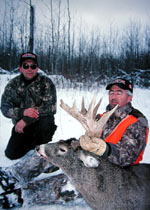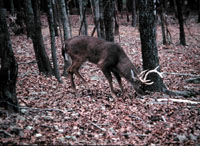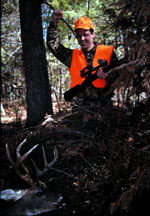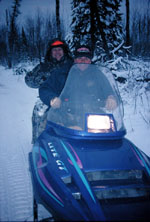
|
Features
|
|
|
|
Books
|
|
|
|
Fun & Games
|
|
|
|
Contact Us
|
|
|
John's Journal... Entry 132, Day 1
TWO-ON-ONE WHITETAILS
Increase Your Whitetail Knowledge
 EDITOR'S
NOTE: Two hunters can take twice as many whitetails
as one hunter can, and two hunters often bag bigger whitetails than one
hunter will. Many of the trophy whitetails bagged in America today are
taken when hunters double-up on bucks, because trophy whitetails know
more about the hunters who hunt them than the sportsmen understand about
the deer that sport high racks and heavy body weights. Find out this week
how doubling-up on deer greatly can increase your chances for bagging
that trophy buck.
EDITOR'S
NOTE: Two hunters can take twice as many whitetails
as one hunter can, and two hunters often bag bigger whitetails than one
hunter will. Many of the trophy whitetails bagged in America today are
taken when hunters double-up on bucks, because trophy whitetails know
more about the hunters who hunt them than the sportsmen understand about
the deer that sport high racks and heavy body weights. Find out this week
how doubling-up on deer greatly can increase your chances for bagging
that trophy buck.
As any great general will tell you, the best way to defeat any enemy is to learn all you can about your adversary. Then you must use what you know to allow your opponent to defeat himself. To consistently take older-age-class bucks, we first must understand how that buck has reached his old age and gained his knowledge.
Trophy bucks...
* hold in thick cover during daylight hours,
* move primarily at night,
* breed does in thick cover even during the rut,
* are very sensitive to the sights, sounds and odors of humans,
* avoid anything they see, hear or smell and don't understand,
* come in from downwind usually to investigate a sight, a sound or an
odor, natural or unnatural,
* survive by fleeing,
* feed, move and breed does as far away from hunting pressure as they
possibly can,
* hide in areas close to human or domestic animal activity in places that
often are obscure and overlooked and
* learn quickly what sights, sounds and odors mean danger.
 A
man drive is one of the most successful strategies a hunter can employ
to bag trophy bucks. Donald Spence of Monticello, Mississippi, the master
of the man drive, hunts with his wife, Jody, almost every day during deer
season. They regularly bag nice-sized bucks every week they hunt.
A
man drive is one of the most successful strategies a hunter can employ
to bag trophy bucks. Donald Spence of Monticello, Mississippi, the master
of the man drive, hunts with his wife, Jody, almost every day during deer
season. They regularly bag nice-sized bucks every week they hunt.
"We look for small thickets no more than 100- to 200-yards long and 40- to 60-yards wide," Spence explained. "The stander takes a position off to one side of the thicket and upwind of the driver. Then his or her human odor will travel down the side of the thicket and not through the thicket. The stander goes in to take a stand as silently as possible to prevent spooking the deer. I try and give Jody 10 minutes to get quiet in her stand before I begin the drive."
Spence utilizes a technique of driving that puts little pressure on the deer. Then the deer walk out instead of sprint from the thicket. The purpose of the drive is not only for the hunter to see the buck but also to enable him to take a shot at a buck that's moving slowly. The Spences use this same tactic whether they're bow-hunting, black-powder hunting or rifle hunting for deer.
"When I'm driving, I walk a zigzag pattern from one side of the thicket to the other side," Spence reported. "I move as slowly and quietly as possible to keep the deer from pinpointing my location. I want my human odor to blow through the thicket and cause the deer to move out in front of me. Whenever I'm on either side of the thicket and in the middle of the thicket, I'll either break a limb or clap my hands loudly. Although these two sounds alert the deer, the animals usually can't pinpoint my exact location in the thicket. Most of the time, a deer will stand up if it's bedding and walk out of the thicket, looking back over its shoulder to try and spot me. As the deer walks out of the thicket and turns back, it'll generally stop about every 15 to 20 yards, which gives Jody an opportunity to get off a shot at a standing buck rather than a walking or a running buck." After the first drive ends, Spence takes a stand while his wife drives the deer.
 "Many
times, the driver will have an opportunity to shoot the deer," Spence
said, "especially if the buck's an older-age- class buck. Often a
big buck will think you'll walk right past him without spotting him, and
he'll remain in the bed as long as you're moving. I've learned when I
see a buck in the bed, I must continue to walk at the same rate of speed.
While walking, I bring my gun to my shoulder and aim. I know as soon as
I stop, the buck will stand up and break to run. Therefore, I am prepared
for the shot by the time I stop."
"Many
times, the driver will have an opportunity to shoot the deer," Spence
said, "especially if the buck's an older-age- class buck. Often a
big buck will think you'll walk right past him without spotting him, and
he'll remain in the bed as long as you're moving. I've learned when I
see a buck in the bed, I must continue to walk at the same rate of speed.
While walking, I bring my gun to my shoulder and aim. I know as soon as
I stop, the buck will stand up and break to run. Therefore, I am prepared
for the shot by the time I stop."
Because Donald and Jody Spence create little noise when they drive these small areas, they can make 10 or 12 drives in a day in the same woodlot. They don't spook the bucks that are 50 to 100 yards away from the small section of woods they're driving. "We use this tactic between 9:00 a.m. and 3:00 p.m.," Spence mentioned. "During this time of the day, most big bucks will bed down in thick cover. From dawn until 9:00 a.m. and from 3:00 p.m. until dusk, we take stands along travel trails between bedding and feeding areas. However, if we don't bag a buck between dawn and 9:00 a.m., more than likely we'll take one using our man-drive technique."
 From
years of driving deer on the same property, the Spences know the escape
routes the older bucks most often use when they're disturbed in their
bedding places. With this knowledge, one of them can take a stand along
these regular escape routes and consistently bag older and bigger bucks
from the same property year after year.
From
years of driving deer on the same property, the Spences know the escape
routes the older bucks most often use when they're disturbed in their
bedding places. With this knowledge, one of them can take a stand along
these regular escape routes and consistently bag older and bigger bucks
from the same property year after year.
To learn more about hunting deer, return to Night Hawk's homepage, and click on books on the left side. You can use PayPal to pay using email nighthawkpub@mindspring.com.
TOMORROW: TEAM TACTICS FOR CLEARCUTS
Check back each day this week for more about The Super Gene ...
Day 1 - Increase Your Whitetail
Knowledge
Day 2 - Team Tactics for Clearcuts
Day 3 - Double Rattling
Day 4 - Hunting Hills and Hollows
Day 5 - How Deer Dictate Where We Hunt